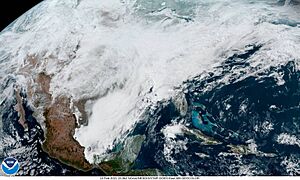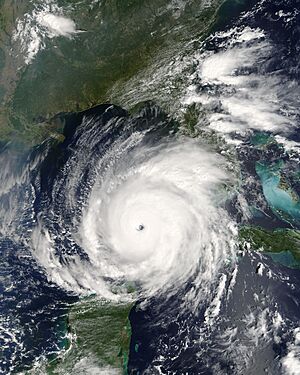Climate of Beaumont, Texas facts for kids
The Climate of Beaumont, Texas is all about the usual weather and the most extreme weather events that have happened in Beaumont, Texas. This city is in a humid subtropical climate, which means it gets hot, humid summers and mild winters. It's also part of the Piney Woods area in eastern Texas. Beaumont gets a lot of rain, more than 65 inches (1,700 mm) every year! That's more than anywhere else in Texas. The warm waters of the Gulf of Mexico make summers hot and sticky, and keep winters mild. Big storms called hurricanes can also hit the area. Some recent big ones include Hurricane Harvey in 2017, Hurricane Rita in 2005, and Hurricane Ike in 2008.
Contents
Temperatures in Beaumont
Summers in Beaumont are usually hot and humid. This is because of all the moisture that blows in from the Gulf of Mexico. Winters are usually mild and not too cold, thanks to the warm gulf waters.
| Monthly normal high and low temperatures (°F) for Beaumont/Port Arthur, Texas | ||||||||||||
| Jan | Feb | Mar | Apr | May | Jun | Jul | Aug | Sep | Oct | Nov | Dec | |
|---|---|---|---|---|---|---|---|---|---|---|---|---|
| 62/43 | 65/46 | 72/52 | 78/59 | 84/66 | 89/72 | 92/74 | 92/73 | 88/69 | 80/60 | 71/51 | 64/44 | |
| ' | ||||||||||||
Rainfall in Beaumont
The Beaumont area gets the most rainfall in Texas, over 65 inches (1,700 mm) each year. This happens because warm, moist air from the Gulf of Mexico moves over the land. As it cools, the moisture turns into rain. The city usually has a wet season from April to October and a dry season from November to March.
Winter Weather
Even though it's rare, snow and ice can happen in Beaumont.
- On December 8, 2017, the Southeast Texas Regional Airport recorded 3 inches of snow.
- Snow also fell on December 11, 2008, December 4, 2009, and Christmas Eve 2004.
- In January 1997, a big ice storm hit the area. It caused power outages and damaged many trees.
- In February 1895, unofficial records say Beaumont got as much as 30 inches of snow during a huge blizzard.
- In February 2021, Winter Storm Uri affected all of Texas, including Beaumont. Many people lost power, and there were problems with low water pressure and travel. It got very cold, reaching 14 degrees Fahrenheit. Snow and sleet totaled 1-2 inches.
- On February 17, Winter Storm Viola brought freezing rain. Many homes and businesses had broken water pipes because of these two storms.
Severe Weather Events
Beaumont can experience strong storms, especially hurricanes.
Hurricanes and Tropical Storms
- October 1886: A strong Category 3 hurricane hit near Sabine Pass. It caused a lot of wind damage and flooding along the coast.
- 1957 - Hurricane Audrey: This Category 3 hurricane hit near the Sabine River. It caused major coastal flooding and wind damage. Over 400 people lost their lives, mostly from drowning in Louisiana.
- 1961 - Hurricane Carla: This large hurricane affected the entire Texas coast. It caused about $2.6 billion in damage (in 2006 dollars). Beaumont saw wind damage, tornadoes, and flooding from this storm.
- 1963 - Hurricane Cindy: A Category 1 hurricane that brought over 20 inches of rain. This caused flooding in 4,000 homes in Jefferson, Orange, and Newton counties.
- 1980 - Tropical Storm Danielle: This storm mainly caused flooding. One person died in Beaumont when their car drove into 15 feet of water.
- 1983 - Hurricane Alicia: This hurricane hit west of Beaumont, but the city still felt some minor effects.
- June 1986 - Hurricane Bonnie: A Category 1 hurricane that brought heavy rain to Beaumont. Some areas got 5 to 10 inches of rain, flooding many homes and businesses. Three people died.
- June 2001 - Tropical Storm Allison: This storm caused the worst damage west of Beaumont, but the city still had flooding. About 7 to 10 inches of rain fell, causing problems on roads.
- September 2005 - Hurricane Rita: This Category 3 hurricane hit near the Texas/Louisiana border with 120 mph winds. It moved through the Beaumont-Port Arthur Metropolitan Area, damaging many buildings and knocking down thousands of trees. Power was out for hundreds of thousands of people. Millions of people left the coast before the storm, making it one of the largest evacuations in U.S. history. Rita was the worst hurricane for Beaumont since Audrey in 1957. It caused $12 billion in damages and 7 deaths.
- September 2007 - Hurricane Humberto: A Category 1 hurricane that caused minor damage.
- September 2008 - Hurricane Ike: This Category 2 hurricane caused major wind damage and storm surge flooding. Many buildings in Beaumont were damaged, even though the strongest winds were west of the city. Ike caused $31 billion in damages and 112 deaths.
- August 2017 - Hurricane Harvey: This Category 4 hurricane hit the lower Texas Coast, then weakened and stalled. As it moved slowly northeast, it brought huge amounts of rain to Southeast Texas. In Beaumont, thousands of homes flooded, and many people needed to be rescued by boat or helicopter. Nederland, a city near Beaumont, received 60.58 inches of rain from Harvey. This set a national record for rainfall from a tropical storm.
- August 2020 - Hurricane Laura: This Category 3 hurricane was expected to hit Beaumont, causing mandatory evacuations. However, Laura moved further east, and Beaumont was spared from its worst impacts. The highest wind gust recorded at Beaumont Municipal Airport was 74 miles per hour.
- October 2020 - Hurricane Delta: This Category 2 hurricane made landfall in Creole, Louisiana. Beaumont and nearby areas had strong winds, falling trees, and many power outages. The highest wind gusts at Jack Brooks Regional Airport reached 90 miles per hour.




